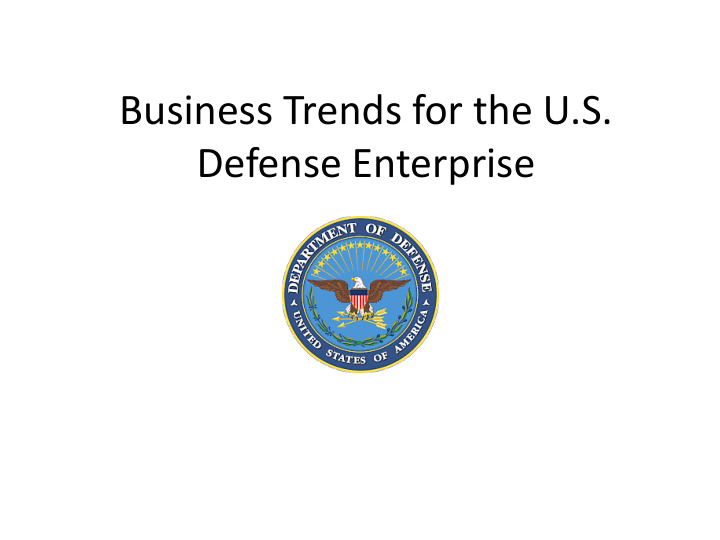



Business Trends for the U.S. Defense Enterprise
$700 Declining Revenue Trends $600 PB 2012 PB 2013 PB 2016 PB 2014 $500 PB 2015 Actuals $Billion, TY $400 Ten-Year ∆ ’s (FY12-23) PB12 to PB13: - $500B $300 PB13 to PB14: - $80B PB14 to PB15: - $190B PB15 to PB16: - $30B $200 PB16 BCA caps: - $170B Total under BCA Sequester: -$970B $100 Analysis does not include funding for Overseas Contingency Operations. $0 2012 2013 2014 2015 2016 2017 2018 2019 2020 2021 2022 2023
Potential Unfunded Liabilities (Average Per Year) • Board of Directors Disapproved Efficiencies (so far) – BRAC ~$2B – Compensation reform ~$4B – Equipment retirement ~$6B – Cruisers ~$1B – Efficiencies denied ~$3B • Sequestration ~$24B • OCO to Base $TBD Total ~$40B
Shrinking New Product Pipeline R&D Investments FY1998-2015 Appropriated & FY2016-2020 PBR 35 Today ( FY 15 Constant Year Dollars in Billions ) 30 25 Today’s Force DOD RDT&E 20 Declining Next Force 5-15 years 15 Next Force 10 Largely Flat 8-20 years 5 Force After Next 0 FY FY FY FY FY FY FY FY FY FY FY FY FY FY FY FY FY FY PB16 PB16 PB16 PB16 PB16 98 99 00 01 02 03 04 05 06 07 08 09 10 11 12 13 14 15 FY16 FY17 FY18 FY19 FY20 DOD BA 1 DOD BA 2 DOD BA 3 DOD BA 4 BA 4 Sequester DOD BA 5 BA 5 Sequester DOD BA 7 BA 7 Sequester
Competitive Landscape • Potential peer competitor revenues growing ~10% per year • Competitor’s New Product Pipeline is Robust • 5 th Generation Fighters • Advanced air-to-air missiles • Radars operating in non-conventional bandwidths • Longer range and precise ballistic and cruise missiles – land and ship attack • Improved undersea warfare systems • Cyber and information operations capabilities • Extensive Electronic Warfare Systems • Advanced Air Defense Systems • Competitor cycle times and costs benefiting from industrial espionage
Technological Superiority Trends Relative to Competitors Near Term (2020) Mid Term (2025) Air Domain Maritime Domain Undersea Domain Electromagnetic Spectrum Space Domain Resilient Comm, ISR, PNT Resilient Basing
What We’re Doing • Secretary Carter: Building the force of the future • Defense Innovative Initiative (DII) • Advanced Capabilities Deterrence Panel (ACDP) • The Third Offset Strategy • Long Range R&D Planning Program (LRRDPP) • Aerospace Innovation Initiative (AII) • Acquisition Reform / Improvement – Better Buying Power 3.0
Better Buying Power 3.0 DRAFT Achieving Dominant Capabilities through Technical Excellence and Innovation Eliminate Unproductive Processes and Bureaucracy Achieve Affordable Programs Emphasize Acquisition Executive, Program Executive Continue to set and enforce affordability caps • • Officer and Program Manager responsibility, authority, and accountability Achieve Dominant Capabilities While Controlling Lifecycle Costs Reduce cycle times while ensuring sound investments • Strengthen and expand “should cost” based cost management • Streamline documentation requirements and staff reviews • Build stronger partnerships between the acquisition, requirements, • and intelligence communities Promote Effective Competition Anticipate and plan for responsive and emerging threats • Create and maintain competitive environments • Institutionalize stronger DoD level Long Range R&D Planning • Improve technology search and outreach in global • markets Incentivize Productivity in Industry and Government Align profitability more tightly with Department goals • Improve Tradecraft in Acquisition of Services Employ appropriate contract types, but increase the use of • Increase small business participation, including more • incentive type contracts effective use of market research Expand the superior supplier incentive program across DoD • Strengthen contract management outside the normal • Increase effective use of Performance-Based Logistics • acquisition chain Remove barriers to commercial technology utilization • Improve requirements definition • Improve the return on investment in DoD laboratories • Improve the effectiveness and productivity of contracted • Increase the productivity of IRAD and CR&D • engineering and technical services Incentivize Innovation in Industry and Government Improve the Professionalism of the Total Acquisition Workforce Increase the use of prototyping and experimentation • Establish higher standards for key leadership positions • Emphasize technology insertion and refresh in program planning • Establish stronger professional qualification requirements • Use Modular Open Systems Architecture to stimulate innovation • for all acquisition specialties Increase the return on Small Business Innovation Research (SBIR) • Strengthen organic engineering capabilities • Provide draft technical requirements to industry early and involve • Ensure the DOD leadership for development programs is • industry in funded concept definition to support requirements technically qualified to manage R&D activities definition Improve our leaders’ ability to understand and mitigate • Provide clear “best value” definitions so industry can propose and • technical risk DoD can choose wisely Increase DoD support for Science, Technology, • Engineering and Mathematics (STEM) education Continue Strengthening Our Culture of: Cost Consciousness, Professionalism, and Technical Excellence
Recommend
More recommend